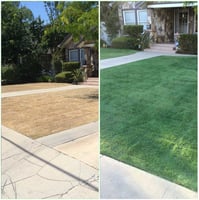Gutters play a crucial role in protecting your home from water damage by channeling rainwater away...
DIY Easy Lawn Sprinkler System Setup + Tips
Learn how to easily set up your own DIY lawn sprinkler system using affordable products and save money on professional installation.
Benefits of DIY Lawn Sprinkler Systems

Installing a DIY lawn sprinkler system comes with several benefits. First and foremost, it allows you to have complete control over the watering schedule of your lawn. You can set the timer to water your lawn at specific intervals, ensuring that it receives the right amount of water without any effort on your part. Additionally, DIY lawn sprinkler systems can save you money in the long run. By using an automated system, you can avoid overwatering and wasting water, which can result in lower water bills. Finally, a well-maintained lawn sprinkler system can help keep your lawn healthy and vibrant, as it ensures that each area of your lawn receives adequate water.
Another benefit of DIY lawn sprinkler systems is the flexibility they offer. You can easily customize the system based on the size and layout of your lawn. Whether you have a small backyard or a large front yard, you can choose the number and placement of sprinkler heads to ensure even coverage. This flexibility allows you to target specific areas that may require more water or adjust the system as your landscaping needs change over time.
Choosing the Right Sprinkler
When setting up a DIY lawn sprinkler system, it's essential to choose the right sprinkler head for your needs. 
Going to make it simple and recommend this one as it has the ability to cover 5000sqft in a circle or set to only a specific range. Get one for each side or just the back and front. Pair with a timer below and optional tripod for auto watering with ease.

If you have a narrow strip of grass then something like this may suffice.
Setting up the Hose and Timer

Once you have chosen the right sprinkler heads, it's time to set up Flexzilla hose(s) or Metal Hoses and WiFi zone activators for your DIY lawn sprinkler system. Start by connecting the hose to a water source, such as an outdoor faucet. Make sure the connection is secure and free from leaks. Next, lay out the hose along the desired areas of your lawn, taking care to avoid any obstacles or areas where the hose may get damaged. If needed, use stakes or clips to secure the hose in place.
After laying out the hose, attach the sprinkler heads to the hose. Make sure they are securely attached and positioned according to your watering needs. Once the sprinkler heads are in place, connect the timer to the hose. Timers allow you to automate the watering process by setting specific schedules and durations. Follow the manufacturer's instructions to program the timer according to your preferences.
Before turning on the water, double-check all connections and make any necessary adjustments. Once everything is set up correctly, turn on the water and test the system to ensure that each sprinkler head is functioning properly and providing adequate coverage.
Optional tripod to extend coverage even more
If you want to extend the coverage of your DIY lawn sprinkler system even further, you may consider using this optional tripod. A tripod can elevate the sprinkler head, allowing it to spray water over a larger area. This can be especially useful if you have tall plants or areas that are difficult to reach with standard sprinkler heads. Tripods are adjustable, allowing you to set the desired height and angle for optimal coverage. Simply attach the sprinkler head to the tripod and position it in the desired location. Make sure to secure the tripod to the ground to prevent it from tipping over.
Using a tripod can help ensure that every corner of your lawn receives adequate water, promoting healthy growth and preventing dry spots. It can also be useful when watering specific areas, such as flower beds or vegetable gardens.
Sometimes a tripod isnt able to help as a 5/8" diameter hose that is 50-100ft long on a spigot will reduce the pressure and flow causing short sprinkler distances. The image above of a golf course with fire hydrant level water flow are powered by advanced engine or electric pressure pumps. To receive this level of irrigation it maybe best to look into pump / backflow prevention and or professional install services. In the meantime, setting up zones on timers that activate with push of a button or timers allows normal pressure water to reach all areas of the lawn and plant beds. Plant bed watering options - misting hoses (50ft (25x2) or soaker hoses. Dont forget splitters and additional activators for these zones if wanting to push a button to turn on.
How much to water?
Once you have some form of irrigation, consider the plants and their roots where the water intake happens. Newly established lawns only need quick frequent applications throughout the day until all grass has germinated. Once germinated, or if using Sod, longer and sparser time periods such as soak everything and let dry for days to encourage the roots to extend into the soil. Proper fertilization is needed to assist in this process as well - ideally every 4 weeks with slower release (consult or ask for service since CleanYardCare or service folks can get it at bulk rates that make it a better deal than you driving to the store to pick up and spread and is better quality)..



